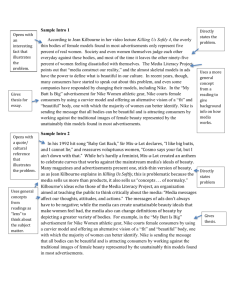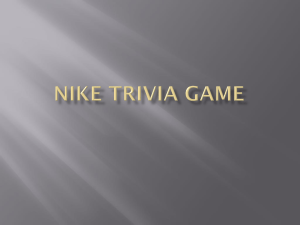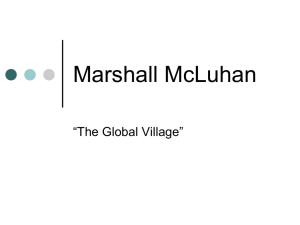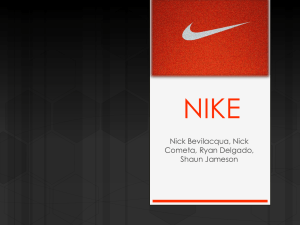Foundations for College Writing Sample Transitions This is a new
advertisement
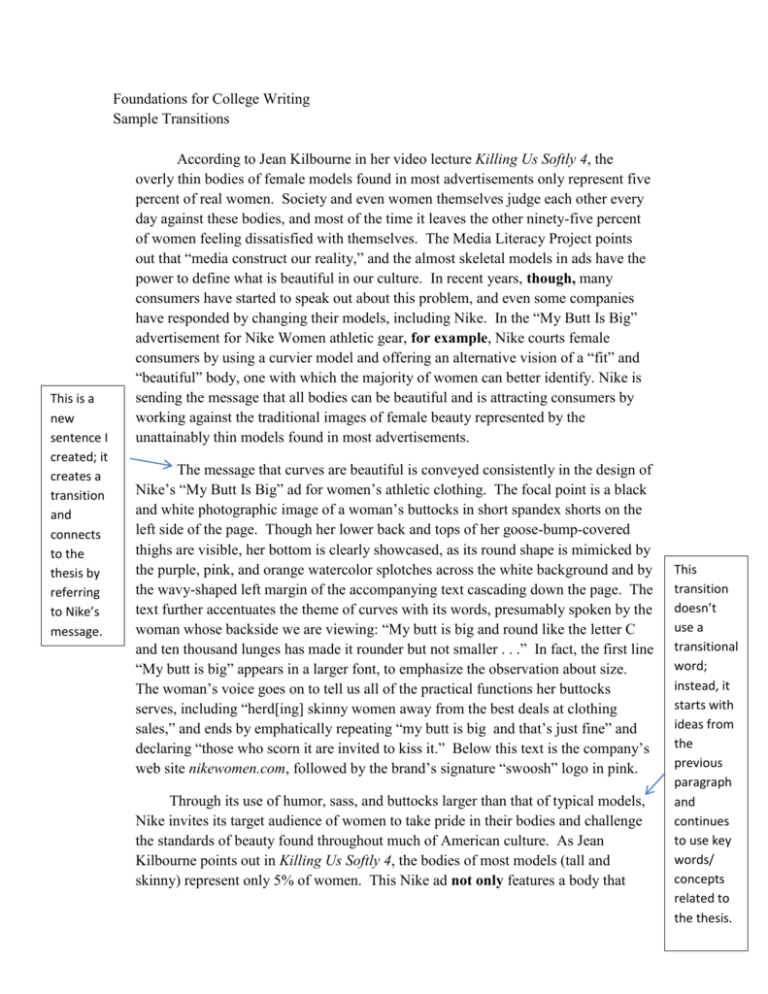
Foundations for College Writing Sample Transitions This is a new sentence I created; it creates a transition and connects to the thesis by referring to Nike’s message. According to Jean Kilbourne in her video lecture Killing Us Softly 4, the overly thin bodies of female models found in most advertisements only represent five percent of real women. Society and even women themselves judge each other every day against these bodies, and most of the time it leaves the other ninety-five percent of women feeling dissatisfied with themselves. The Media Literacy Project points out that “media construct our reality,” and the almost skeletal models in ads have the power to define what is beautiful in our culture. In recent years, though, many consumers have started to speak out about this problem, and even some companies have responded by changing their models, including Nike. In the “My Butt Is Big” advertisement for Nike Women athletic gear, for example, Nike courts female consumers by using a curvier model and offering an alternative vision of a “fit” and “beautiful” body, one with which the majority of women can better identify. Nike is sending the message that all bodies can be beautiful and is attracting consumers by working against the traditional images of female beauty represented by the unattainably thin models found in most advertisements. The message that curves are beautiful is conveyed consistently in the design of Nike’s “My Butt Is Big” ad for women’s athletic clothing. The focal point is a black and white photographic image of a woman’s buttocks in short spandex shorts on the left side of the page. Though her lower back and tops of her goose-bump-covered thighs are visible, her bottom is clearly showcased, as its round shape is mimicked by the purple, pink, and orange watercolor splotches across the white background and by the wavy-shaped left margin of the accompanying text cascading down the page. The text further accentuates the theme of curves with its words, presumably spoken by the woman whose backside we are viewing: “My butt is big and round like the letter C and ten thousand lunges has made it rounder but not smaller . . .” In fact, the first line “My butt is big” appears in a larger font, to emphasize the observation about size. The woman’s voice goes on to tell us all of the practical functions her buttocks serves, including “herd[ing] skinny women away from the best deals at clothing sales,” and ends by emphatically repeating “my butt is big and that’s just fine” and declaring “those who scorn it are invited to kiss it.” Below this text is the company’s web site nikewomen.com, followed by the brand’s signature “swoosh” logo in pink. Through its use of humor, sass, and buttocks larger than that of typical models, Nike invites its target audience of women to take pride in their bodies and challenge the standards of beauty found throughout much of American culture. As Jean Kilbourne points out in Killing Us Softly 4, the bodies of most models (tall and skinny) represent only 5% of women. This Nike ad not only features a body that This transition doesn’t use a transitional word; instead, it starts with ideas from the previous paragraph and continues to use key words/ concepts related to the thesis. Bolded words represent transitional markers used within the paragraph to show how ideas relate. defies this ideal through its curves, but also uses a racially ambiguous model to make the body easier to identify with for most female customers. The model’s skin tone is darker than her shorts, but in a medium tone such that this model could be of almost any race or ethnicity. Moreover, the woman’s skin appears to have goose bumps, indicating that the photo has been left “untouched” by Photoshop, sending the message that her skin looks fine as it appears naturally. The ad also uses humor when the woman explains that she uses her buttocks to shoo skinny women away from clothing sales; her buttocks not only has confidence, but also serves practical functions like keeping its owner warm (“it serves as a heater for my side of the bed”), and in this way, it seems like a good friend. In this ad, the larger than idealized buttocks is welcomed and celebrated instead of being seen as a body part that should be reduced in size through exercise. The text hugging the model and the round, bright watercolor splotches, which almost suggest her body is a work of art, emphasize the concept that curves are good and things of beauty. Although Kilbourne warns us that ads objectify and dehumanize women when they chop them into body parts, the speaking voice of the woman whose buttocks we are viewing seems to make her very much a thinking, feeling human being. Again, transition is created by starting the topic sentence with the main idea of the previous paragraph, then shifting to the new idea. It also relates back to the thesis. By creating a “body positive” ad, Nike Women creates strong ethical appeal. The customer feels like she can trust Nike because the brand is not shaming her for not meeting the “ideal” body we see in most advertising. Instead, the brand builds credibility with its audience of women by allowing the customer to feel like a sassy, confident woman. This also creates emotional appeal, as many female customers will embrace the value of being “body positive” and enjoy the good-natured use of humor. While the ad may not seem to use much logical appeal, the list of reasons why the woman’s buttocks is great do offer new ways to consider why we should love and embrace our bodies. To sum up, using a “regular” woman—what the Media Literacy Project would call the “plains folks” technique of showing average people using a product for customers to identify with—and humor fit the purpose of luring customers in with a version of female beauty that is desirable AND attainable. While the ultimate motive of Nike is to sell products, of course, many customers might be impressed by the secondary motive of making women feel good about themselves.
